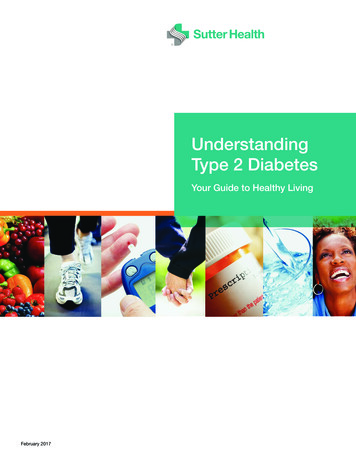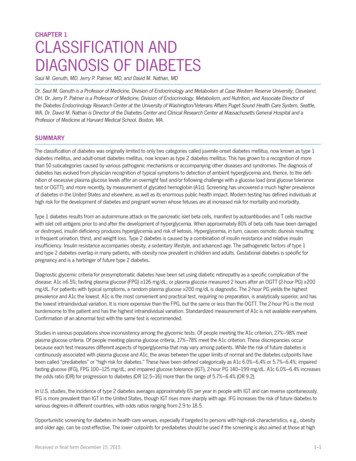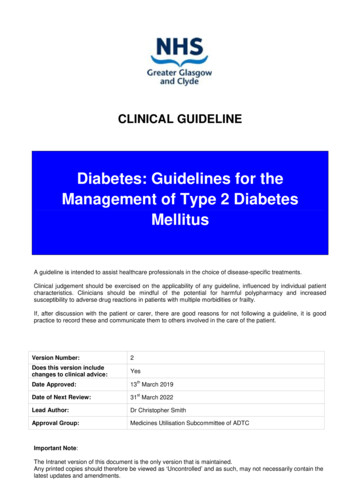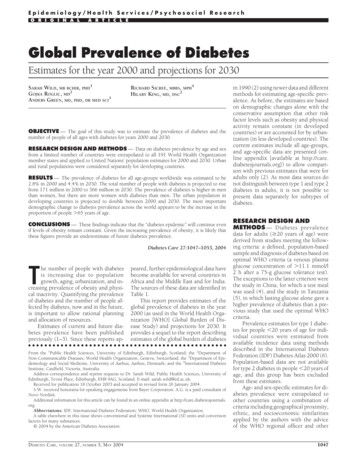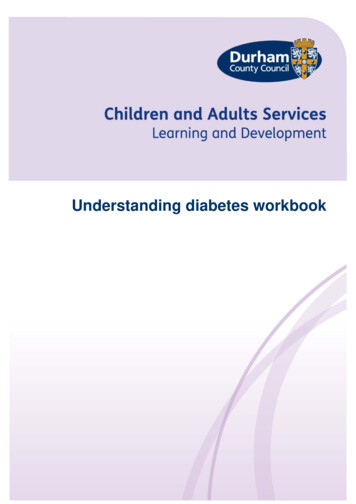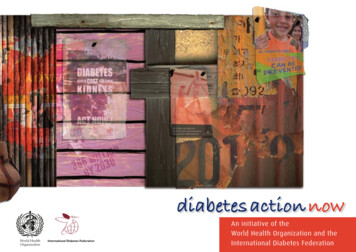
Transcription
diabetes action nowWorld HealthOrganizationAn initiative of theWorld Health Organization and theInternational Diabetes Federation
7(/ ,IBRARY #ATALOGUING IN 0UBLICATION ATA IABETES !CTION .OW !N INITIATIVE OF THE 7ORLD (EALTH /RGANIZATION AND THE )NTERNATIONAL IABETES &EDERATION IABETES MELLITUS 0OPULAR WORKS ) 7ORLD (EALTH /RGANIZATION)3". 8 7ORLD (EALTH /RGANIZATION .,- CLASSIFICATION 7 )NTERNATIONAL IABETES &EDERATION !LL RIGHTS RESERVED 0UBLICATIONS OF THE 7ORLD (EALTH /RGANIZATION CAN BE OBTAINED FROM -ARKETING AND ISSEMINATION 7ORLD (EALTH /RGANIZATION !VENUE !PPIA 'ENEVA 3WITZERLAND TEL FAX EMAIL BOOKORDERS WHO INT ) & PUBLICATIONS CAN BE ORDERED ONLINE FROM THE ) & BOOKSHOP AT WWW IDF ORG BOOKSHOP 2EQUESTS FOR PERMISSION TO REPRODUCE OR TRANSLATE 7(/ PUBLICATIONS n WHETHER FOR SALE OR FOR NONCOMMERCIAL DISTRIBUTION n SHOULD BE ADDRESSED TO 0UBLICATIONS AT THE ABOVE ADDRESS FAX EMAIL PERMISSIONS WHO INT 4HE DESIGNATIONS EMPLOYED AND THE PRESENTATION OF THE MATERIAL IN THIS PUBLICATION DO NOT IMPLY THE EXPRESSION OF ANY OPINION WHATSOEVER ON THE PART OF THE 7ORLD (EALTH /RGANIZATION CONCERNING THELEGAL STATUS OF ANY COUNTRY TERRITORY CITY OR AREA OR OF ITS AUTHORITIES OR CONCERNING THE DELIMITATION OF ITS FRONTIERS OR BOUNDARIES OTTED LINES ON MAPS REPRESENT APPROXIMATE BORDER LINES FOR WHICHTHERE MAY NOT YET BE FULL AGREEMENT 4HE MENTION OF SPECIFIC COMPANIES OR OF CERTAIN MANUFACTURERS PRODUCTS DOES NOT IMPLY THAT THEY ARE ENDORSED OR RECOMMENDED BY THE 7ORLD (EALTH /RGANIZATION IN PREFERENCE TO OTHERS OF A SIMILARNATURE THAT ARE NOT MENTIONED %RRORS AND OMISSIONS EXCEPTED THE NAMES OF PROPRIETARY PRODUCTS ARE DISTINGUISHED BY INITIAL CAPITAL LETTERS 4HE 7ORLD (EALTH /RGANIZATION DOES NOT WARRANT THAT THE INFORMATION CONTAINED IN THIS PUBLICATION IS COMPLETE AND CORRECT AND SHALL NOT BE LIABLE FOR ANY DAMAGES INCURRED AS A RESULT OF ITS USE ESIGN BY "RUCE 7 3TEPHENS !SSOC *ULIE -URRAYPrinted in Switzerland
The world is facing a growing diabetes epidemic of potentially devastating proportions. Its impact will“be felt most severely in developing countries. The World Health Organization and the International DiabetesFederation are working together to support ongoing initiatives to prevent and manage diabetes and itscomplications, and to ensure the best quality of life possible for people with diabetes worldwide.Together we are helping to provide countries with the means to face the challenges that lie ahead.It is time for diabetes action now”Dr Robert BeagleholeWorld Health OrganizationProf Pierre LefèbvreInternational Diabetes FederationThe Diabetes Action Now programme2Key messages4A life-threatening condition7A rising global burden9Living a full and healthy life11The urgent need for prevention13Responding to the challenges141diabetes action now
Thediabetes action nowprogrammediabetes action nowmuch“ofI myusedtimeto spendin taverns,smoking and drinking. Thiswas the time to give upsmoking. I still have theoccasional drink. I spendmuch more time with my familyand I have a richer life asa result. We also eat muchmore healthily.”/UPA 'UMEDE IS A 3OUTH !FRICANBUSINESSMAN WHOWAS DIAGNOSED WITHTYPE DIABETES TWOYEARS AGO (E RUNS ATRANSPORT BUSINESS ASWELL AS A PRE SCHOOL (E EMPHASIZES THEIMPORTANCE OF EDUCATIONIN HELPING PEOPLEWITH DIABETES TO ACCEPTTHEIR CONDITION is a joint initiative of the World Health Organization and theInternational Diabetes Federation. It is one of several initiatives being undertaken by WHO and IDF,globally, regionally and within countries, that together have the overall goal of reducing the impact ofdiabetes and related chronic conditions upon the health of children and adults worldwide.diabetes action now is being supported by a World Diabetes Foundation grant to IDF andWHO funds.The programme focuses on low- and middle-income communities, particularly in developingcountries. Its purpose is to stimulate and support the adoption of effective measures for thesurveillance, prevention and control of diabetes. A key aim of the programme is to achieve asubstantial increase in global awareness about diabetes and its complications.Over the next three years,)N MANY COUNTRIES DIABETESCONSUMES BETWEEN AND OF THE HEALTHCARE BUDGETAND MORE THAN OF THATCOST IS DUE TO DIABETICCOMPLICATIONS diabetes action now will:1. work to achieve a major increase in awareness about diabetes, its complications, and itsprevention, particularly among health policy makers in low- and middle-income countriesand communities;2. initiate and support projects to generate and widely disseminate new knowledge onawareness about diabetes and its economic impact in low- and middle-income communities;3. produce and widely disseminate a new scientifically-based review on the prevention ofdiabetes and the complications of diabetes;4. produce up-to-date, practical guidance for policy makers in low- and middle-income countries,on the contents, structure and implementation of national diabetes programmes; and5. provide and maintain a web-based resource to help policy makers implement nationaldiabetes programmes.2
The overall purpose ofdiabetes action nowTo stimulate and support the adoption of effectivemeasures for the surveillance, prevention andcontrol of diabetes in low- and middle-incomecountries and communities.3
Diabetes is a major threat to globalpublic health that is rapidly getting worse,Four key messages about diabetesDIABETES is a common condition and its frequency isdramatically rising all over the worldDIABETES is alife-threatening condition At least 171 million people worldwide have diabetes. This figureis likely to more than double by 2030. In developing countries the number of people with diabetes willincrease by 150% in the next 25 years. The global increase in diabetes will occur because of populationageing and growth, and because of increasing trends towardsobesity, unhealthy diets and sedentary lifestyles. In developed countries most people with diabetes are above theage of retirement, whereas in developing countries those mostfrequently affected are aged between 35 and 64. Worldwide, 3.2 million deaths are attributable to diabetesevery year. One in 20 deaths is attributable to diabetes; 8,700 deathsevery day; six deaths every minute. At least one in ten deaths among adults between 35 and 64 yearsold is attributable to diabetes. Three-quarters of the deaths among people with diabetes agedunder 35 years are due to their condition.These estimates are based on relative differences in risk of death between people with diabetes and thosewithout. They include deaths where diabetes would have been the underlying cause of death or would have beenmentioned as a contributory condition on the medical certificate of cause of death.4
diabetes action nowand the biggest impact is on adults ofworking age in developing countriesA full and healthy lifeis possible with DIABETESIn many cases,DIABETES can be prevented Studies have shown that, with good management, many of thecomplications of diabetes can be prevented or delayed. Effective management includes lifestyle measures such asa healthy diet, physical activity, maintaining appropriate weightand not smoking. Medication often has an important role to play, particularly for thecontrol of blood glucose, blood pressure and blood lipids. Through the provision of optimal health care the risk ofdeveloping diabetic complications can be reduced substantially. Helping people with diabetes to acquire the knowledge andskills to manage their own condition is central to their leading afull and healthy life. The prevention of type 1 diabetes is not yet possible and remainsan objective for the future. The prevention of type 2 diabetes hasbeen shown to be possible and requires action now. Trials have shown that sustained lifestyle changes in diet andphysical activity can reduce the risk of developing type 2diabetes. For example, the Finnish Diabetes PreventionStudy showed that a better diet, increased physical activityand modest weight loss could substantially reduce thedevelopment of type 2 diabetes in middle-aged adults at high risk. In all the studies conducted so far in people at high risk, lifestylechanges have been substantially more effective than the use of drugs. The scale of the problem requires population-wide measuresto reduce levels of overweight and obesity, and physical inactivity. Informed policy decisions on transport, urban design, and on foodpricing and advertising can play an important part in reducingthe population-wide risks of developing type 2 diabetes.5
'URDEEP AUR I was falling into“Ianfeltabysswhen I wasdiagnosed. In my partof the world, diabetes wasnot a very commonly detectedproblem back then. Theonly person with diabetes Ihad known before was mymother’s sister, whose failinghealth had kept her atdeath’s door for almost threedecades. I was petrified.”Deaths attributable to diabetesPROFESSOR ANDPRINCIPAL OF A LEADINGWOMEN S COLLEGE IN)NDIA WAS FIRSTDIAGNOSED WITHGESTATIONAL DIABETESMELLITUS WHILEPREGNANT WITH HERSECOND CHILD MORETHAN YEARS AGO 3HE DEVELOPED TYPE DIABETES ABOUT NINEMONTHS AFTER DELIVERY 0ROFESSOR AUR KEEPSGOOD CONTROL OF HERDIABETES WITH REGULARMORNING WALKS AND AWELL REGULATEDDIETARY REGIMENREINFORCED ZEALOUSLYBY HER HUSBAND ANDTWO CHILDREN 3ELF MONITORING OFGLUCOSE BECAME ARITUAL UNTIL SHELEARNED TO ADJUST HERDOSE OF INSULIN %UROPE4OTAL THOUSAND YEARS THOUSAND-IDDLE %AST4OTAL THOUSAND YEARS THOUSAND!FRICA4OTAL THOUSAND YEARS THOUSAND4HE !MERICAS4OTAL THOUSAND YEARS THOUSAND!SIA AND !USTRALASIA4OTAL MILLION YEARS THOUSAND OF DEATHS ATTRIBUTABLE TO DIABETES YEARS 4OTAL 4OTAL NUMBER OF DEATHS ATTRIBUTABLE TO DIABETES IN YEARS .UMBER OF DEATHS ATTRIBUTABLE TO DIABETES AMONG TO YEAR OLDS IN Almost half ofpeople with type 2diabetes are NOTaware that they havethis life-threateningcondition.These estimates are based on relative differences in risk of death between peoplewith diabetes and those without. They include deaths where diabetes wouldhave been the underlying cause of death or would have been mentioned as acontributory condition on the medical certificate of cause of death.6
What is diabetes?Diabetes is a chronic condition that occurs when the pancreas does not produceenough insulin or when the body cannot effectively use the insulin it produces.A life-threatening conditionHyperglycaemia and other related disturbances in the body’s metabolism canlead to serious damage to many of the body’s systems, especially the nerves andIn 2000, 3.2 million people died from complications associatedwith diabetes.blood vessels.There are two basic forms of diabetes:In countries with high diabetes prevalence, such as those in thePacific and the Middle East, as many as one in four deaths in adultsaged between 35 and 64 years is due to diabetes.Type 1: people with this type of diabetes produce very little or no insulin.Diabetes has become one of the major causes of premature illnessand death in most countries, mainly through the increased risk ofcardiovascular disease (CVD). Cardiovascular disease is responsiblefor between 50% and 80% of deaths in people with diabetes.A third type of diabetes, gestational diabetes mellitus (GDM), develops duringType 2: people with this type of diabetes cannot use insulin effectively.Most people with diabetes have type 2.some cases of pregnancy but usually disappears after pregnancy.People with type 1 diabetes require daily injections of insulin to survive.People with type 2 diabetes can sometimes manage their condition withDiabetes is a leading cause of blindness, amputation and kidneyfailure. These complications account for much of the social andfinancial burden of diabetes.lifestyle measures alone, but oral drugs are often required, and less frequentlyinsulin, in order to achieve good metabolic control.Common symptoms of type 1 diabetes include: excessive thirst; constant hunger;Although diabetes is sometimes considered a condition ofdeveloped nations, the loss of life from premature death amongpersons with diabetes is greatest in developing countries.excessive urination; weight loss for no reason; rapid, hard breathing; visionchanges; drowsiness or exhaustion. These symptoms may occur suddenly.People with type 2 diabetes may have similar, but less obvious, symptoms.The burden of premature death from diabetes is similar to that ofHIV/AIDS, yet the problem is largely unrecognized.Many have no symptoms and are only diagnosed after many years of onset.As a consequence, almost half of all people with type 2 diabetes are not awarethat they have this life-threatening condition.7
Prevalence of diabetes“I don’t do any specialsports nor do I weigh myselfat home but I do look aftermyself. I think about mydiabetes almost every timeI eat and try not to eat toomuch. My teachers don’tknow that I have diabetesand I have only told my twobest friends.”#HUL (EE (AN IS A HIGH SCHOOLSTUDENT WHO WASDIAGNOSED WITH TYPE DIABETES IN "ORNIN 3OUTH OREA #HULMOVED TO !USTRALIAAT THE AGE OF SEVEN (IS FATHER HAD TYPE DIABETES AND DIED OF AHEART ATTACK AT THE AGEOF IABETES HAS NOTMADE A DIFFERENCE TO#HUL OR *AMES AS HISFRIENDS CALL HIM AS FARAS SCHOOL AND SPORT ISCONCERNED AND HE DOESEVERYTHING THAT HISFRIENDS DO %UROPE MILLION MILLION-IDDLE %AST MILLION MILLION!FRICA MILLION MILLION4HE !MERICAS MILLION MILLION!SIA AND!USTRALASIA MILLION MILLIONThe top 10 countries,in numbers of peoplewith diabetes, are:0REVALENCE OF DIABETES IN PERSONS YEARSThe number ofpeople withdiabetes will morethan double in thenext 25 years, toreach a total of 366million by ilItalyBangladesh NUMBER OF PEOPLE WITH DIABETES IN NUMBER OF PEOPLE WITH DIABETES IN 3OURCE 7ILD ET AL Year20002030RankingCountryPeople with diabetes (millions)1India31.779.42China20.842.33United States of America17.730.38
A rising global burdenThese projections of the number of people with diabetes in 2030 take intoaccount the fact that there will be more people in the world (populationgrowth) and that there will be more elderly people (population ageing).They also take into account trends in urbanization - the fact that people aremoving from rural areas to cities, particularly in developing countries. Thisaffects the number of people who are likely to have diabetes, because peopleliving in cities in developing countries tend to be less physically active andhave higher levels of overweight and obesity than people in rural areas. Infact, current trends in obesity suggest that these projections are conservativeand that the increase in the prevalence of diabetes may be even greater.In developing countries it is people in the middle, productive years of their liveswho are particularly affected by diabetes. In these countries three-quarters ofall people with diabetes are under 65 years old and 25% of all adults withdiabetes are younger than 44. In developed countries, more than half of allpeople with diabetes are older than 65, and only 8% of adults with diabetesare younger than 44.ʻʻ EVELOPED COUNTRIES !GE GROUP YEARS EVELOPING COUNTRIES %STIMATED NUMBER OF PEOPLEWITH DIABETES MILLIONSThe number of people with diabetes will more than double overthe next 25 years, to reach a total of 366 million by 2030. Mostof this increase will occur as a result of a 150% rise in developingcountries.%STIMATED NUMBER OF PEOPLEWITH DIABETES MILLIONS !GE GROUP YEARS Estimated number of adults with diabetes.In 2000, there were approximately171 million people, worldwide, with diabetes9
Diabetes - who is at risk?Type 1 diabetes“All that’s needed to dispelanxieties about diabetes is alittle education. I’ve spoken toaudiences, some who don’teven know me, and themessage is basically that ‘wellif that guy can play cricketwith diabetes, I can cope too’.That’s so important.”7ASIM !KRAM FORMER 0AKISTAN CRICKETCAPTAIN WAS DIAGNOSEDWITH TYPE DIABETES ATTHE AGE OF (E ISCURRENTLY INVOLVED INSPORTS COMMENTARYAND CRICKET COACHINGAND IS ACTIVE IN RAISINGAWARENESS ABOUTDIABETES AND ITSPREVENTION (E REJECTS THE NOTIONTHAT DIABETES HAS ANEGATIVE EFFECT NOTONLY ON THE BODY OF APERSON BUT ALSO ON THEMIND Although the onset of type 1 diabetes is typically in childhood it also occurs in adults. People witha strong family history of type 1 diabetes are at increased risk. Certain types of blood tests may alsoidentify those at high risk.Type 2 diabetesAdults and children who are overweight or obese and are physically inactiveWeight gain may result in insulin resistance in which the body is unable to use the insulin it produceseffectively. At the same time, physical inactivity, both a cause and consequence of weight gain, alsocontributes to insulin resistance. The problem of obesity and overweight is extending to developingcountries, especially in urban areas.Certain ethnic groupsEthnicity is an important risk factor with, for example, higher rates of type 2 diabetes reported inpeople of Asian and African origin, and in indigenous peoples of the Americas and Australasia.Individuals with a family history of diabetesStudies have shown that people who have a strong family history of diabetes, such as in a parent orsibling, are at high risk of developing diabetes.The costs of diabetes tothe individual and thefamily are not onlyfinancial, the intangiblecosts of pain, anxietyand reduced quality oflife have a tremendousimpact but are difficultto measure.Women who have had gestational diabetes mellitusWomen who developed diabetes during pregnancy are at greater risk of type 2 diabetes later in life.In general, the number of men and women with diabetes is similar until old age (over 65 years) whenmore women have diabetes.10
Living a full and healthy lifeStudies have shown that many complications of diabetes can be prevented or delayed througheffective management. This includes lifestyle measures such as a healthy diet, physical activity, theavoidance of overweight and obesity, and not smoking. Preventative care need not involve costlytreatment or medication. Education in good foot care as well as regular inspection is a good exampleof a low cost method of prevention.Diabetes therapy is not only about lowering glucose, but also about the overall reduction in the riskfactors for diabetic complications, which includes the control of blood pressure and blood lipids.This requires lifelong care and management.Health systems that are able to deliver optimal care need to be designed around the needs of theperson with the condition, as on a day to day basis most diabetes care is undertaken by the personwith diabetes and not the health professional. Diabetes education plays a key role in empoweringpeople with the knowledge and skills to manage their own condition effectively.In order to prevent or delay complications, people with diabetes may have to modify their lifestyle.People with type 2 diabetes often require oral drugs, and sometimes insulin to control their bloodglucose levels. People with type 1 diabetes require insulin to survive.Although insulin has been designated an essential drug by WHO, it is not yet universally accessible toall those who need it in the majority of countries of the world. Continuous access to insulin remains amajor problem in many developing countries especially those in sub-Saharan Africa. In some of thesecountries people with diabetes die because they cannot get the insulin they need to survive.11
Obesity is increasing rapidly in both developed and developing countries. This reflectsI was among those who“attendedthe first diabeteseducation course in Georgia in1987. Besides basic knowledgeon the main topic, we wereshown what role regular bloodglucose monitoring may play It was very exciting to see withyour own eyes how drugs anddiet influence your bloodglucose levels. So propertreatment, excellent oralhypoglycaemic agents andeducation have helped me tolive an active life and enjoy it.”-ELENTI URASHVILI IS A FORMER IRECTOR OFTHE )NSTITUTE OF0ROFESSIONAL ISEASES IN'EORGIA AND CURRENTLYHONORARY PROFESSOR OFTHE 0ROFESSIONAL ISEASE #HAIR OF THE-EDICAL 5NIVERSITY (E WAS DIAGNOSED WITHTYPE DIABETES YEARS AGO (E HAS NOT HAD ANYCOMPLICATIONS EXCEPTFOR NON PROLIFERATIVERETINOPATHY WHICH WASTREATED WITH LASERCOAGULATION 0ROF URASHVILI S FATHERHAD DIABETES AS DOFOUR OF HIS FIVEBROTHERS declining levels of physical activity and the rising consumption of diets high in sugars and fats. Thistrend is also obvious among young people. A generation is entering adulthood with unprecedentedlevels of obesity. According to the International Obesity Task Force (IOTF) and the WHO WorldHealth Report 2002, about 58% of diabetes globally can be attributed to body mass index (BMI)above 21 kg/m2.Obesity and type 2 diabetes are linked. Weight gain leads to insulin resistance through severalmechanisms. Insulin resistance places a greater demand on the pancreas to produce insulin. At thesame time, physical inactivity, both a cause and consequence of weight gain, also contributes to insulinresistance. Diabetes occurs when the body’s need for insulin outstrips the ability of the pancreas toproduce it.The sheer scale of the obesity and diabetes epidemics require responses at a population level, as well asby individuals. Approaches based only on personal education to promote behaviour change areunlikely to succeed in an environment where there are plentiful inducements to engage in opposingbehaviours. Personal education must be supported by appropriate changes to the broader environment,such as transportation, urban design, advertising and food pricing.WHO and IDF support numerous strategies, worldwide, aimed at addressing issues associatedwith diet and physical activity. It is recognized that only through constructive partnerships,involving governments, civil society and private sector, can the necessary changes be made that willreverse current trends towards overweight and obesity and the range of chronic diseases associatedwith them.60% of the world’spopulation do notdo enough physicalactivity.12
Design Paprika - Photo: Stockbyte TMThe urgent need for preventionSeveral approaches have been tried to prevent type 1 diabetes but none of them have been shown towork, and the prevention of type 1 diabetes remains an objective for the future.However, simple lifestyle measures have been shown to be effective in preventing or delaying the onsetof type 2 diabetes. They include:7 April 2002MOVE FOR HEALTH! AT LEAST 30 MINUTES PER DAY Increased physical activity – it is estimated that currently 60% of the world’s population do notdo enough physical activity, with adults in developed countries most likely to be inactive. Studieshave shown that just 30 minutes of moderate exercise a day, five days a week, is enough to promotegood health and reduce the chances of developing type 2 diabetes. A healthy diet – eating between three and five servings of fruit and vegetables a day and eating lesssugar and saturated fats has been shown to be important in maintaining appropriate weight, andtherefore a lower risk of type 2 diabetes. Weight loss – more than one billion adults worldwide are overweight; at least 300 million of whomare obese. It is estimated that well over half of all cases of type 2 diabetes could be avoided ifexcessive weight gain in adults could be prevented. Non-smoking – people with diabetes are at greater risk of dying from coronary heart disease,stroke and peripheral vascular disease than people without the condition. Smoking increases therisk even further.13POUR VOTRE SANTÉ, BOUGEZ ! AU MOINS 30 MINUTES PAR JOURPOR TU SALUD, MUÉVETE ! AL MENOS 30 MINUTOS AL DÍAWORLD HEALTH ORGANIZATION
Responding tothe challengesAttention to diet and“exerciseis really mostimportant. It’s how I havebeen able to ward off anycomplications. But, ofcourse I am no saint. Isuppose we all tend togravitate to being less thandiligent about certainthings we should be doingall the time but I have acheck-up every six months,which is extremelyimportant.”has become better“ Diabetesunderstood in recent years,but we still have a longway to go.”One billion adultsworld wide areoverweight –at least 300 millionare obese.4HE (ON *UDI-OYLAN -0 IS AN !USTRALIAN-EMBER OF0ARLIAMENT ANDCURRENTLY #HAIR OFTHE 0ARLIAMENTARY0UBLIC 7ORKS#OMMITTEE #HAIROF THE !USTRALIA #HINA &RIENDSHIP'ROUP AND #HAIR OFTHE 0ARLIAMENTARY IABETES 3UPPORT'ROUP THAT SHEESTABLISHED IN *UDI WAS DIAGNOSEDWITH TYPE DIABETESIN IABETES HAS NOTHAD A NEGATIVEEFFECT ON HERPOLITICAL CAREERDESPITE HAVINGCONSTANTLY TO FLYFROM 0ERTH TO#ANBERRA AND BACKTO ATTEND OFTENDEMANDINGPARLIAMENTARYSESSIONS 3INCE SHE HAS WORKED HARDTO OVERCOMECOMPLACENCYIGNORANCE FEARAND THE GAPS INGENERAL PUBLICKNOWLEDGE ABOUTTHE PREVALENCE OFDIABETES Over the next three years diabetes action nowwill respond to the challenges outlined in thisbooklet in the following ways.It will work to achieve a major increase inawareness about diabetes, its complications,and its prevention, particularly among healthpolicy makers in low- and middle-income countriesand communities. It will do this at a globallevel, using a variety of means, including use of themass media and direct contact with policy makers.In addition, similar work will take place in severalWHO and IDF regions, using materials that havebeen adapted to regional needs.The programme will initiate and support projects togenerate and widely disseminate new knowledge onlevels of awareness about diabetes and its economicimpact in low- and middle-income communities.14Currently there are very few systematic studieson awareness about diabetes, whether amongstpolicy makers, the general public, or people withdiabetes. Similarly, although there are somestudies on the economic impact of diabetes in richcountries, there are very few from low- andmiddle-income countries, where the impact islikely to be different. Such information is essentialto guide efforts to raise awareness about thesignificance of diabetes to public health. Mostof this work will take place in collaboration withgroups within countries.diabetes action now will produce and widelydisseminate a new scientifically-based review on theprevention of diabetes and diabetic complications.The last review was produced by WHO in 1994.Since then much new evidence has emerged.
The programme will produce up-to-date, practicalguidance for policy makers in low- and middleincome countries, on the contents, structure andimplementation of national diabetes programmes.The guidance will have two main sections; ageneric section that will apply to health systemrequirements for all chronic diseases, including forexample cardiovascular disease and chronicrespiratory disease, and a section highlighting thespecific needs for diabetes prevention and care.This work will be undertaken in collaboration withother relevant groups within WHO.diabetes action now will establish and maintaina web-based resource to assist policy makers in theimplementation of chronic disease and nationaldiabetes programmes. The resource is likely toinclude educational materials, treatment guidelinesand training manuals developed in different settings,an up-to-date source of practical, evidence-basedinformation, and online access to expert advice. It isappreciated that in many areas access is poor, and inthe longer run hard-copy materials will be produced.Ongoing globaland regional activitiesMany other important activities and initiatives arealready in existence, most of which can be foundthrough the IDF web site (www.idf.org).They include:World Diabetes Day, a joint IDF–WHO day of globalactivities which takes place on November 14th eachyear to raise awareness of different aspects ofdiabetes and its complications.Regional declarations on diabetes, which bringtogether regional partners, including WHO and IDF,to form a strong alliance for addressing diabeteswithin each region.Diabetes congresses, conferences and workshops,which provide forums for reviewing scientificevidence and producing guidance on itsimplementation to improve prevention andhealth care.IDF consultative sections and IDF task forces, suchas the Task Force on Diabetes Health Economics andthe Task Force on Prevention and Screening, areengaged in numerous activities that complementthe diabetes action now programme.15
“Diabetes is a part oflife for me. I am not nordo I feel sick and I live anormal life. I am dependanton insulin but independent asa person.”-ARÓA &LORENCIA&ONTANA is fromRio Cuarto, Argentina.She was diagnosedwith type 1 diabetesat the age of five.3HE HAS DECIDED THATSHE WOULD LIKE TO STUDYLAW AT UNIVERSITY SOTHAT SHE CAN PURSUE ACAREER IN POLITICS AFTERGRADUATION (ER ULTIMATE GOAL IS TOBECOME A MEMBEROF PARLIAMENT World Health OrganizationInternational Diabetes FederationThe World Health Organization, the UnitedNations specialized agency for health, wasestablished on 7 April 1948. WHO’s objective isthe attainment by all peoples of the highestpossible level of health. Health is defined as astate of complete physical, mental and socialwell-being and not merely the absence ofdisease or infirmity. The main functions of theWHO diabetes group are:The International Diabetes Federation (IDF) is1. To oversee the development and adoption ofinternationally agreed standards and normsfor the diagnosis and treatment of diabetes,its complications and risk factors;2. To promote and contribute to the surveillanceof diabetes, its complicatio
Diabetes is a leading cause of blindness, amputation and kidney failure. These complications account for much of the social and fi nancial burden of diabetes. Although diabetes is sometimes considered a condition of developed nations, the loss of life from premature death among persons with


